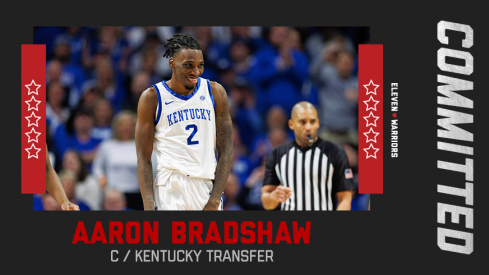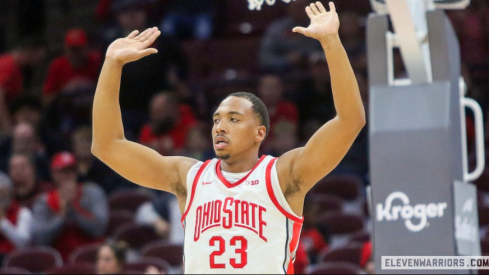
After a slow start, the Ohio State offense had perhaps its most impressive performance to date, putting up 63 points against the Nebraska Cornhuskers. Though the Buckeye offense had assists from the team's other units—getting defensive and special team touchdowns as well as a third touchdown set up by a Bradley Roby interception—the Ohio State offense was not stopped for the game's final three quarters. Ohio State scored on seven of its last nine drives, with a fumble stopping an eighth drive in Nebraska territory. Ironically, the Buckeye offense put up prolific numbers through old school principles—a run-heavy offense sprinkled with play-action passing. But the difference is Ohio State's ability to spread the field yet change the 'arithmetic' through Braxton Miller.
Nebraska: You Shall not pass
Nebraska does a good job in their coverage unit. We knew they did that. That's a pro style, very good scheme . . . --Urban Meyer Press Conference
Ohio State's slow first quarter start was a combination of Nebraska unveiling an uber-aggressive game plan and OSU getting away from what they do well. Nebraska unveiled perhaps the most aggressive defense against the Buckeyes to date (in a season of run-first defenses). The Cornhuskers generally played a one-high cover 1 defense with no defender beyond ten yards.

Nebraska borrowed a page from Michigan State and brought simultaneous A gap and edge blitzes, often from the boundary corner.
Ohio State unsuccessfully responded by attacking with a dropback-based passing game. Ohio State went three and out (including a fake punt) on its first four possessions. Of those twelve plays, the Buckeyes called passes on seven. Those plays generated .167 yards per attempt. Ohio State repeatedly used snag and spacing triangle combinations against Nebraska's man-coverage. While good in theory, Ohio State was poor in execution. The Buckeyes had difficulty picking up Nebraska's blitzes.
When they did, the Ohio State receivers had difficulty getting open. Small windows were available but Miller is not yet comfortable going through a five receiver progression or 'throwing people open' and was hesitant as a result. For example, here Nebraska does not rush but just 'fences' Miller in. Miller is clearly confused in his reads. Rather than run, he holds the ball far too long.
Meanwhile, during those four series Miller only had one called run. The result was a sputtering offense.
Spacing to Run (Or How to Spread-to-Run Teams Can Exploit Man Coverage)
. . . but it's not conducive to quarterback run. So we felt going into that that we were going to run the quarterback, which obviously is our best player.--Meyer
Then, starting with Miller's 72-yard run on inverted veer, Ohio State put on an applied seminar on how to use the spread-to-run alignment to attack a cover 1 defense (and why cover 1 is not necessarily the best choice against a spread QB run team). The Buckeyes used 11 personnel (3 WR, 1 TE, 1 RB) and generally put twins or trips to the field. The natural reaction of a one-high defense when the offense uses trips is to 'shift' the free safety towards the three wide receivers. Nebraska did this. The problem for the Cornhuskers is that this left no in-box safety support against the Ohio State run game. The Nebraska defenders have to account for the Buckeye wide receivers but for the free safety, who shades the trips. When Oho State runs a play such as QB counter trey (like QB outside zone) there is no read involved—it is simply using the quarterback as the tailback and the tailback as the fullback.

As such, even though Nebraska was playing an aggressive defense, OSU was able to use their man coverage to extract defenders from the box while still being able to utilize its full run game. Below, Andrew Norwell does a great job reading the DE crashing and logs him instead of kicking out, and Miller was untouched to the end zone. Note how Jake Stoneburner in the slot shows a bubble screen upon the snap, pulling the outside linebacker who has No. 3 man coverage responsibility away from the play.
Ohio State was able to use this same arithmetic to its advantage in the pass game. The Buckeyes shifted to an entirely play-action and sprint-out pass game. Below, though Nebraska looks like they have two safeties, they only have one free. The other is responsible for the number 2 receiver to his side. He reacts to flare action. The linebacker responsible for the tight end is held by the play fake, allowing the tight end to get inside and past. The free safety is unable to react in time because he has been pulled over by the trips, resulting in two big seam throws to the tight end.
The Buckeyes also used formation to pull man coverage defenders away from the trips. OSU implemented trips in combination with a tackle-over (tackle and tight end trade places). This meant that the Buckeyes still had two receivers to the weak side. In man coverage, Nebraska had to play this look straight up and could not shade to trips. That gave OSU easy sprint-out completions to their primary receiver, Corey Brown.
Beauty in Simplicity
"We’re kind of a pound-you offense right now,” Meyer said. “I don’t mind that. I’ve not had a lot of those.”
After the first quarter, however, the passing game was merely a complement to the Buckeye bread-and-butter run game. Ohio State gained 371 yards rushing off of three primary plays—the aforementioned QB counter trey, inside zone read, and inverted veer.
Inside zone read is this offense's default play. It is the Buckeye's jab, designed to keep Ohio State ahead of schedule and set up everything else in the offense. Like the outside QB zone discussed last week, inverted veer complements inside zone in a different manner. Again, a spread-to-run offense's goal is to create edge confusion. From shotgun, a defense will play games based upon halfback alignment. While the zone read attacks the backside end, inverted veer attacks the playside end. It also uses the same blocking scheme as counter trey (or power), except in this instance the defensive end is eliminated by read rather than kick-out block.

This one-two punch also fits the Buckeye personnel. If the inside zone is the jab then Carlos Hyde is the fist. Hyde will not make defenders miss, but he hits the hole hard and gains yards after contact. The Ohio State line—particularly the left side—does a great job creating an initial push into the defense's bubble and Hyde is able to exploit that for four-yard chunks. Inverted veer, by contrast, puts Miller in a position that he can quickly get the second level. The play had been ineffective until Nebraska, however, because Miller always gave even when the defensive end clearly widened with the sweep.
Against Nebraska that changed, with the resulting 'explosive plays.' Below, Marcus Hall collapsed the front side, Reid Fragel locked up the playside linebacker, and Miller in the secondary is always a positive situation for the Buckeyes.
From there, the Ohio State passing game becomes effective when it builds off the run threat and gives Miller discrete options. One of Meyer's strengths is that he ensures that every run play has a corresponding play-action pass. Here, Ohio State initial action is precisely the same as the zone read arc block I highlighted last week. But Jeff Heuerman releases to the flat. Again, Nebraska does not account for the TE because they shade to the twins and the linebacker bites on play-action, leading to an easy touchdown completion.
Ohio State had the same success with inverted veer play-action.The play-action movement passing also renders Miller more likely to run. He is moved toward the edge, has several reads and when they are not there he can take off. Miller's difficulty comes from when he sits in the pocket too long.
Stay Within Your Lane
The Ohio State offense again demonstrated that it does well within its strengths. The Buckeyes get in trouble when they move away from that and become too dependent upon the downfield passing game. Yes, teams are game planning to take away the Ohio State run game. But Meyer & Co. have been able to use spread principles with alignment and constraint plays to prevent teams from effectively doing so. Plus, what the Buckeyes do well, they do very well. The OSU line is playing at a high level, assisted by the no-huddle's tempo. Hyde has demonstrated his ability to keep OSU ahead of schedule. And Rod Smith showed his immense talent with an impressive touchdown run. If Smith can continue to run like this it adds a different big-play dimension to this offense.
Of course, it is all made possible by Miller's dynamic running ability. Time and again the Ohio State offense sputters until they begin using Miller in the run game. Miller's big-play threat opens up everything else. It also appears to have an effect upon Miller. It gets him in the flow of the game and makes him more decisive in the pass game as to whether he should run or pass. Miller and the Buckeye passing game are not prepared to beat good pass defenses with a pro-style pass game. But he is without peer as a runner, and Ohio State can operate a very effective play-action passing game off an extremely effective run game. The upside is that this fits precisely within Urban Meyer's philosophy.

